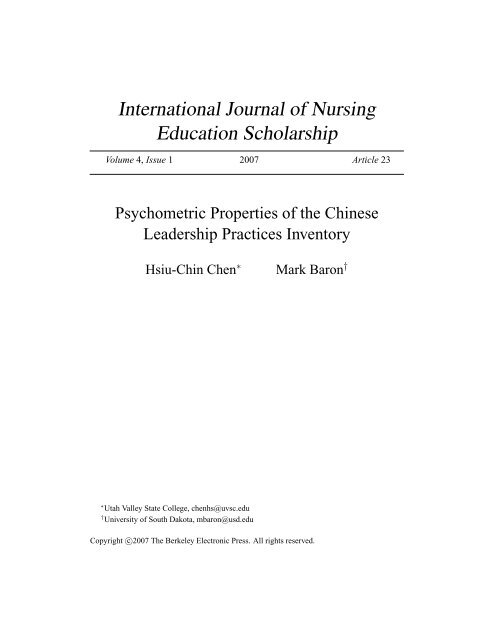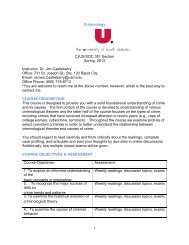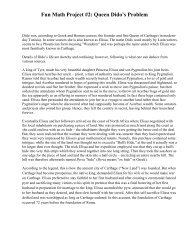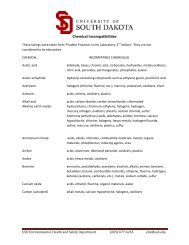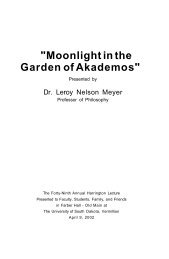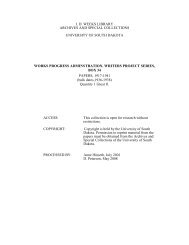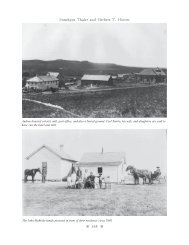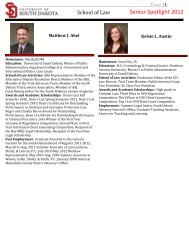Psychometric Properties of the Chinese Leadership Practices ...
Psychometric Properties of the Chinese Leadership Practices ...
Psychometric Properties of the Chinese Leadership Practices ...
You also want an ePaper? Increase the reach of your titles
YUMPU automatically turns print PDFs into web optimized ePapers that Google loves.
International Journal <strong>of</strong> Nursing<br />
Education Scholarship<br />
Volume 4, Issue 1 2007 Article 23<br />
<strong>Psychometric</strong> <strong>Properties</strong> <strong>of</strong> <strong>the</strong> <strong>Chinese</strong><br />
<strong>Leadership</strong> <strong>Practices</strong> Inventory<br />
Hsiu-Chin Chen ∗ Mark Baron †<br />
∗ Utah Valley State College, chenhs@uvsc.edu<br />
† University <strong>of</strong> South Dakota, mbaron@usd.edu<br />
Copyright c○2007 The Berkeley Electronic Press. All rights reserved.
<strong>Psychometric</strong> <strong>Properties</strong> <strong>of</strong> <strong>the</strong> <strong>Chinese</strong><br />
<strong>Leadership</strong> <strong>Practices</strong> Inventory<br />
Hsiu-Chin Chen and Mark Baron<br />
Abstract<br />
There is little evidence <strong>of</strong> psychometric properties <strong>of</strong> <strong>the</strong> <strong>Leadership</strong> <strong>Practices</strong> Inventory (LPI)<br />
when used with Taiwan’s nursing faculty. The purpose <strong>of</strong> this study was to examine psychometric<br />
properties <strong>of</strong> <strong>the</strong> <strong>Chinese</strong> LPI and provide a culturally appropriate instrument for use in Taiwan’s<br />
nursing. Thirteen bachelor and nine associate degree nursing programs were eligible for participation.<br />
The <strong>Chinese</strong> LPI was used to ga<strong>the</strong>r nursing faculty’s perceptions <strong>of</strong> leadership behaviors<br />
<strong>of</strong> nursing deans and directors. A total <strong>of</strong> 369 questionnaires were returned. <strong>Psychometric</strong> examinations<br />
used content validity, internal consistency reliability, item analysis, and construct and<br />
concurrent validities. Cronbach’s alpha <strong>of</strong> <strong>the</strong> <strong>Chinese</strong> LPI total scale was .96. Three factors were<br />
extracted that explained 59.5 % <strong>of</strong> <strong>the</strong> variance. Concurrent validity was supported by <strong>the</strong> <strong>Chinese</strong><br />
Multifactor <strong>Leadership</strong> Questionnaire (MLQ-5X). Findings for <strong>the</strong> psychometric properties and<br />
cultural appropriateness <strong>of</strong> <strong>the</strong> <strong>Chinese</strong> LPI supported its potential as an instrument for measuring<br />
nursing leadership in Taiwan.<br />
KEYWORDS: psychometrics, content validity, factor analysis, item analysis, concurrent validity
Chen and Baron: <strong>Psychometric</strong>s <strong>of</strong> <strong>the</strong> <strong>Chinese</strong> LPI<br />
Effective leadership has played a critical role in operating an<br />
organization’s performance. The central role <strong>of</strong> effective leadership is to build a<br />
relationship between those who aspire to lead and those who choose to follow<br />
(Kouzes & Posner, 2002). Studies have been conducted to explore how leadership<br />
can be used to influence subordinates for better organizational accomplishment.<br />
The outcome <strong>of</strong> <strong>the</strong>se studies relied heavily on using qualified instruments to<br />
examine leaders’ performance on different leadership dimensions (Zagorsek,<br />
Stough, & Jaklic, 2006). Accurate assessment <strong>of</strong> leadership can contribute a<br />
substantial body <strong>of</strong> knowledge about <strong>the</strong> relationship between leadership and<br />
social-psychological phenomenon, and provide useful feedback for leaders to<br />
understand <strong>the</strong>ir leadership behaviors, as perceived by <strong>the</strong>ir subordinates.<br />
One <strong>of</strong> <strong>the</strong> most developed and tested instruments is <strong>the</strong> Posner and<br />
Kouzes’ (1988) <strong>Leadership</strong> <strong>Practices</strong> Inventory (LPI) based on five practices <strong>of</strong><br />
exemplary leadership. Yet, <strong>the</strong>re is little evidence regarding psychometric<br />
properties <strong>of</strong> its use in nursing education, especially in Taiwan. Therefore, <strong>the</strong><br />
main purpose <strong>of</strong> this study was to examine psychometric properties <strong>of</strong> <strong>the</strong> <strong>Chinese</strong><br />
LPI and to provide a culturally appropriate instrument for use in Taiwan’s nursing<br />
education.<br />
The following research questions were addressed in this study: (1) what<br />
are Cronbach’s alpha coefficients, item-to-item, and item-to-total correlations <strong>of</strong><br />
<strong>the</strong> <strong>Chinese</strong> LPI-observer according to item analysis for internal consistency<br />
reliability? (2) what is <strong>the</strong> construct validity <strong>of</strong> <strong>the</strong> <strong>Chinese</strong> LPI-observer assessed<br />
by Taiwan’s nursing faculty? and (3) are <strong>the</strong> <strong>Chinese</strong> LPI-observer total and<br />
subscales significantly correlated with <strong>the</strong> <strong>Chinese</strong> Multifactor <strong>Leadership</strong><br />
Questionnaire (MLQ-5X) for concurrent validity assessment?<br />
BACKGROUND<br />
In <strong>the</strong> 1980s, transformational leadership became a well-known topic in<br />
psychology, management, sociology, and political science. The concept <strong>of</strong><br />
transformational leadership stimulated researchers’ interest in understanding <strong>of</strong><br />
<strong>the</strong> leadership process that goes beyond <strong>the</strong> dimensions <strong>of</strong> consideration <strong>of</strong><br />
subordinates’ feeling and initiating subordinates toward goal accomplishment.<br />
Integrated into transformational leadership <strong>the</strong>ory are trait, behavior, and<br />
contingency approaches, while incorporating and building upon charismatic and<br />
political leadership. As its name implies, transformational leadership motivates<br />
individuals to change and promotes followers’ awareness and acceptance <strong>of</strong> <strong>the</strong><br />
group’s vision and mission.<br />
Published by The Berkeley Electronic Press, 2007<br />
1
International Journal <strong>of</strong> Nursing Education Scholarship, Vol. 4 [2007], Iss. 1, Art. 23<br />
Based on <strong>the</strong> previous studies <strong>of</strong> leadership, Bass (1985) proposed a more<br />
expanded and refined version <strong>of</strong> transformational leadership <strong>the</strong>ory.<br />
Transformational leaders motivate subordinates to do more than originally<br />
expected, and accordingly, subordinates’ confidence levels are elevated and needs<br />
satisfied. The main task <strong>of</strong> Bass’ transformational leadership research is <strong>the</strong><br />
development <strong>of</strong> <strong>the</strong> Multifactor <strong>Leadership</strong> Questionnaire (MLQ) used to identify<br />
<strong>the</strong> transformational, transactional, and laissez-faire leadership styles (Bass, 1985).<br />
The MLQ has been revised several times and has been used in nearly 200 research<br />
programs, doctoral dissertations, and master <strong>the</strong>ses around <strong>the</strong> world (Bass &<br />
Avolio, 2000).<br />
Similar to <strong>the</strong> concept <strong>of</strong> transformational leadership <strong>the</strong>ory, Posner and<br />
Kouzes’ (1988) visionary or exemplary leadership proposed that outstanding<br />
leaders use five practices <strong>of</strong> behaviors to facilitate employees to achieve<br />
organizational goals. Visionary leaders search for opportunities to change <strong>the</strong><br />
status quo, inspire a shared vision and set a model to foster collaboration,<br />
empower employees to pursue a potential future, and recognize <strong>the</strong> contributions<br />
<strong>of</strong> employees to <strong>the</strong> overall success <strong>of</strong> <strong>the</strong> organization. The five practices <strong>of</strong><br />
exemplary leadership have subsequently been developed into <strong>the</strong> <strong>Leadership</strong><br />
<strong>Practices</strong> Inventory (LPI).<br />
The LPI developed by Posner and Kouzes (1988) is used to assess<br />
leadership behavior. A conceptual leadership model on which <strong>the</strong> LPI is based<br />
was developed through a qualitative study including a survey <strong>of</strong> 1,100 managers,<br />
and was generated from 38 in-depth interviews <strong>of</strong> managers. Content analysis was<br />
employed to analyze <strong>the</strong> data collected from <strong>the</strong> managers who had personal best<br />
experience being leaders. Five practices <strong>of</strong> exemplary leadership were <strong>the</strong>n<br />
identified. After <strong>the</strong> development <strong>of</strong> <strong>the</strong> five practices, <strong>the</strong> LPI focused on<br />
articulating scale items. The feedback <strong>of</strong> administering <strong>the</strong> LPI obtained from<br />
Masters <strong>of</strong> Business Administration students, experts, and managers formed a 30item<br />
instrument with six items reflecting each <strong>of</strong> <strong>the</strong> five leadership practices.<br />
Each item was cast on a 5-point Likert scale scored from 1 (seldom or rarely) to 5<br />
(very <strong>of</strong>ten) representing <strong>the</strong> frequency <strong>of</strong> using a leadership behavior. Two<br />
parallel forms were developed to evaluate <strong>the</strong> leadership behaviors described by<br />
<strong>the</strong> leaders (LPI-self) or observed by <strong>the</strong> subordinates (LPI-observer).<br />
<strong>Psychometric</strong> evaluation <strong>of</strong> <strong>the</strong> LPI was examined using a sample <strong>of</strong> 2,876<br />
managers and subordinates who worked in a variety <strong>of</strong> private and public sector<br />
companies (Posner & Kouzes, 1988). Internal reliabilities <strong>of</strong> <strong>the</strong> five subscales<br />
ranged from .70 to .84 for <strong>the</strong> LPI-self and .79 to .91 for <strong>the</strong> LPI-observer. The<br />
average <strong>of</strong> test-retest reliability was .94. A principal components factor analysis<br />
http://www.bepress.com/ijnes/vol4/iss1/art23<br />
2
Chen and Baron: <strong>Psychometric</strong>s <strong>of</strong> <strong>the</strong> <strong>Chinese</strong> LPI<br />
(PCA) with varimax rotation was conducted to extract five factors accounting for<br />
59.9% <strong>of</strong> <strong>the</strong> variance. The loadings <strong>of</strong> <strong>the</strong> five factors ranged from .37 to .73<br />
were reported.<br />
An additional examination <strong>of</strong> <strong>the</strong> psychometric properties <strong>of</strong> <strong>the</strong> LPI<br />
involved over 36,000 managers and subordinates representing private and public<br />
companies (Posner & Kouzes, 1993). Internal reliabilities for <strong>the</strong> five subscales <strong>of</strong><br />
<strong>the</strong> LPI-self ranged from .70 to .85 and .81 to .92 for <strong>the</strong> LPI-observer. Test-retest<br />
reliability for <strong>the</strong> five practices was above <strong>the</strong> .93 level. Five factors were<br />
extracted from a PCA with varimax rotation, and accounted for 60.2% <strong>of</strong> <strong>the</strong><br />
variance. The findings consistently supported <strong>the</strong> LPI for measuring <strong>the</strong> five<br />
leadership practices (Posner & Kouzes, 1993). Even in <strong>the</strong> latest third edition <strong>of</strong><br />
<strong>the</strong> LPI, proposed is that some question items were revised and reordered in item<br />
number. The five practices remained <strong>the</strong> same and psychometric properties were<br />
consistent with <strong>the</strong> first edition (Kouzes & Posner, 2000).<br />
The extensive testing has revealed that <strong>the</strong> LPI exhibited sound<br />
psychometric properties. Yet, a study using <strong>the</strong> item response <strong>the</strong>ory to analyze its<br />
reliability found that some items are redundant and contribute little to <strong>the</strong> overall<br />
precision <strong>of</strong> <strong>the</strong> instrument (Zagorsek et al., 2006). Moreover, <strong>the</strong>re are no reports<br />
<strong>of</strong> psychometric properties when <strong>the</strong> LPI is used in <strong>the</strong> healthcare system<br />
(Tourangeau & McGilton, 2004). Because <strong>of</strong> <strong>the</strong> limited evidence <strong>of</strong> <strong>the</strong> LPIs<br />
psychometric evaluation in nursing research, Tourangeau and McGilton collected<br />
data from 67 LPI-self <strong>of</strong> nurse managers and 347 LPI-observer <strong>of</strong> nurses, and<br />
aimed at narrowing <strong>the</strong> knowledge gap <strong>of</strong> psychometric properties <strong>of</strong> <strong>the</strong> LPI used<br />
in nursing fields.<br />
Computerized search from 1990 to 2005, including nursing (CINAHL),<br />
medical literature (Medline), and <strong>the</strong> “Dissertation and Thesis Abstract System”<br />
in Taiwan’s Ministry <strong>of</strong> Education databases, indicated that <strong>the</strong> LPI has not been<br />
used to evaluate leadership <strong>of</strong> nursing administration in Taiwan. Before<br />
instruments can be used for populations o<strong>the</strong>r than those for whom <strong>the</strong>y were<br />
originally developed, assessment <strong>of</strong> psychometric properties and validation <strong>of</strong><br />
cultural appropriateness are essential (Lee, Farran, Tripp-Reimer, & Sadler, 2003).<br />
Researchers are convinced that an instrument is required to have rigid reliability<br />
and validity tests before being used in leadership research in order to examine <strong>the</strong><br />
behaviors <strong>of</strong> leaders and <strong>the</strong> related factors affecting <strong>the</strong> relationship between<br />
leaders and subordinates (Huber et al., 2000).<br />
Published by The Berkeley Electronic Press, 2007<br />
3
International Journal <strong>of</strong> Nursing Education Scholarship, Vol. 4 [2007], Iss. 1, Art. 23<br />
Study Design<br />
METHODS<br />
This was a cross-sectional survey study using self-administered<br />
questionnaires. The study procedures consisted <strong>of</strong> four stages including<br />
translation and back-translation <strong>of</strong> <strong>the</strong> first edition <strong>of</strong> <strong>the</strong> LPI, an expert panel<br />
review for content validation, a pilot test stage, and a study stage. The purpose <strong>of</strong><br />
translating a research instrument is to achieve semantic equivalence for<br />
conducting a cross-cultural study with non-English-speaking populations. A<br />
modified version <strong>of</strong> Brislin’s (1986) translation method was used to translate <strong>the</strong><br />
LPI into <strong>the</strong> <strong>Chinese</strong> version. The modified procedures were as follows: (1)<br />
provide <strong>the</strong> English LPI to a bilingual person who was familiar with Taiwan’s<br />
culture; (2) instruct <strong>the</strong> bilingual person to translate <strong>the</strong> English LPI into <strong>the</strong><br />
<strong>Chinese</strong> version; (3) have <strong>the</strong> o<strong>the</strong>r bilingual person who was qualified for<br />
bilingual teaching in Taiwan blindly translate <strong>the</strong> <strong>Chinese</strong> version back to an<br />
English version; and (4) ask three bilingual raters individually to compare <strong>the</strong><br />
English and <strong>Chinese</strong> versions for semantic equivalence. All raters and translators<br />
held masters degrees and had taught in English teaching institutions. Similar to<br />
<strong>the</strong> process <strong>of</strong> translation and back translation used in Wang, Lee, and Fetzer’s<br />
(2006) study, strategies including selecting qualified translators, a review panel,<br />
and a pilot test on target population helped to maximize <strong>the</strong> translation<br />
equivalence <strong>of</strong> <strong>the</strong> <strong>Chinese</strong> LPI.<br />
An expert panel review for content validation <strong>of</strong> <strong>the</strong> <strong>Chinese</strong> LPI is critical<br />
for assuring <strong>the</strong> content holds <strong>the</strong> similar meaning with <strong>the</strong> original one and<br />
appropriately fits for Taiwan’s culture. Three bilingual pr<strong>of</strong>essors who held<br />
doctoral degrees and had worked as leaders in Taiwan’s nursing administration<br />
were invited. These experts were asked to rate items for linguistic and conceptual<br />
clarity, representative <strong>of</strong> Taiwan’s culture and background, and <strong>the</strong> relevance <strong>of</strong><br />
<strong>the</strong> identified concept. Each item was rated by a 4-point ordinal rating scale<br />
scored from 1 to 4. The average congruency percentage (ACP) among raters was<br />
96%, indicating acceptable items if percentage is 90% or higher (Waltz,<br />
Strickland, & Lenz, 2005). The relevance and representative <strong>of</strong> item-level content<br />
validity index (I-CVI) for <strong>the</strong> 30-item <strong>Chinese</strong> LPI were 1.0 and .99, respectively.<br />
An item is considered well for use if <strong>the</strong> I-CVI is 1.0 rated by five or fewer<br />
experts (Lynn, 1986). According to <strong>the</strong> comments <strong>of</strong> linguistic clarity obtained<br />
from <strong>the</strong> expert panel, ambiguous wording was revised to better accommodate<br />
Taiwan’s nursing educational settings.<br />
http://www.bepress.com/ijnes/vol4/iss1/art23<br />
4
Permissions for conducting this study were approved by <strong>the</strong> university’s<br />
Institutional Review Board and each <strong>of</strong> <strong>the</strong> participating nursing schools in<br />
Taiwan. A convenience sample <strong>of</strong> 15 faculty members was piloted from a junior<br />
nursing college in Taiwan to determine <strong>the</strong> readability <strong>of</strong> <strong>the</strong> <strong>Chinese</strong> LPI.<br />
Eligibility criteria <strong>of</strong> selecting subjects for <strong>the</strong> pilot test included full-time female<br />
and male nursing faculty holding ranks <strong>of</strong> instructor, assistant pr<strong>of</strong>essor, associate<br />
pr<strong>of</strong>essor, or pr<strong>of</strong>essor. The faculty were asked to provide <strong>the</strong>ir comments about<br />
whe<strong>the</strong>r <strong>the</strong> instructions were clear and if <strong>the</strong> question items were easy to answer.<br />
No items were modified.<br />
Population and Sample<br />
A minimum sample size <strong>of</strong> 20 full-time nursing faculty members from<br />
each school was required for selection. In 2003, 13 baccalaureate and nine<br />
associate degree nursing programs were eligible for this study. To qualify for this<br />
study, each female and male subject was required to be full-time faculty, an<br />
instructor, assistant pr<strong>of</strong>essor, associate pr<strong>of</strong>essor, or pr<strong>of</strong>essor. An adequate<br />
sample size for factor analysis and validity and reliability analyses was<br />
determined to be at least 300 subjects in this study (Tabachnick & Fidell, 2001).<br />
Twenty faculty members were randomly selected from each <strong>of</strong> <strong>the</strong> 13 schools<br />
with baccalaureate nursing programs for participation. To ensure adequate<br />
representation, all nursing faculty from each <strong>of</strong> <strong>the</strong> nine associate nursing<br />
programs were recruited. In terms <strong>of</strong> <strong>the</strong> needed sample size, 516 questionnaires<br />
were mailed to <strong>the</strong> potential participants to reach a projected 60% response rate.<br />
Data were collected in a confidential manner. Participation was voluntary, and<br />
questionnaires were answered anonymously. The completed questionnaires were<br />
returned directly to <strong>the</strong> investigator through mail.<br />
Measures<br />
Chen and Baron: <strong>Psychometric</strong>s <strong>of</strong> <strong>the</strong> <strong>Chinese</strong> LPI<br />
The <strong>Chinese</strong> LPI-observer was used to ga<strong>the</strong>r <strong>the</strong> faculty’s perceptions <strong>of</strong><br />
<strong>the</strong>ir deans’ or directors’ five practices <strong>of</strong> leadership behavior in this study.<br />
Because <strong>of</strong> <strong>the</strong> small sample size <strong>of</strong> nursing deans and directors (n = 22), no<br />
attempt was made to collect data <strong>of</strong> self-evaluation <strong>of</strong> leadership practices. The<br />
<strong>Chinese</strong> LPI translated from <strong>the</strong> first edition is a 30-item questionnaire with a 5point<br />
Likert scale scored from 1 (seldom or rarely) to 5 (very <strong>of</strong>ten) representing<br />
<strong>the</strong> frequency <strong>of</strong> using a leadership behavior. Five subscales compose <strong>the</strong> <strong>Chinese</strong><br />
LPI with six question items in each subscale. The five subscales include<br />
challenging <strong>the</strong> process, inspiring a shared vision, enabling o<strong>the</strong>rs to act,<br />
modeling <strong>the</strong> way, and encouraging <strong>the</strong> heart. The <strong>Chinese</strong> Multifactor<br />
<strong>Leadership</strong> Questionnaire Form 5X (MLQ-5X) developed by Shieh, Mills, and<br />
Published by The Berkeley Electronic Press, 2007<br />
5
International Journal <strong>of</strong> Nursing Education Scholarship, Vol. 4 [2007], Iss. 1, Art. 23<br />
Waltz (2001) was used to examine <strong>the</strong> concurrent validity <strong>of</strong> <strong>the</strong> <strong>Chinese</strong> LPI. The<br />
MLQ-5X was selected because <strong>of</strong> its widespread use and <strong>the</strong> similarity <strong>of</strong><br />
underlying concepts. The <strong>Chinese</strong> MLQ-5X has 36 items, which was developed<br />
to measure 233 nursing faculty’s perceptions <strong>of</strong> <strong>the</strong>ir deans’ and directors’<br />
leadership styles <strong>of</strong> transformational, transactional, and laissez-faire in Taiwan.<br />
The Cronbach’s alphas <strong>of</strong> <strong>the</strong> <strong>Chinese</strong> MLQ-5X total and each subscale ranged<br />
from .71 to .94. The CVI was .75 and 1.0, as assessed by doctoral bilingual<br />
pr<strong>of</strong>essors (Shieh et al., 2001). In Chen and Baron’s (2006) study for examining<br />
175 nursing faculty’s job satisfaction and <strong>the</strong>ir perceptions <strong>of</strong> leadership styles <strong>of</strong><br />
nursing directors, <strong>the</strong> <strong>Chinese</strong> MLQ-5X consistently demonstrated acceptable<br />
internal reliability (α = .70 to .88).<br />
<strong>Psychometric</strong> Analysis<br />
The internal consistency <strong>of</strong> <strong>the</strong> <strong>Chinese</strong> LPI-observer was assessed using<br />
Cronbach’s alpha, and <strong>the</strong> acceptable coefficient was set at .70 (Kerlinger & Lee,<br />
2000). Item analyses including item-total and inter-item correlations were<br />
performed to examine <strong>the</strong> homogeneity and multi-collinearity <strong>of</strong> <strong>the</strong> <strong>Chinese</strong> LPIobserver.<br />
Acceptable coefficients for item-total correlations are greater than .30,<br />
which indicate items contributing to <strong>the</strong> measure; and greater than .30 and less<br />
than .80 for interitem correlations, which coefficients greater than .80 indicate<br />
redundant items because <strong>of</strong> multicollinearity (Tabachnick & Fidell, 2001).<br />
A PCA using varimax rotation was first computed in an attempt to<br />
replicate <strong>the</strong> five factors, as originally proposed by Posner and Kouzes (1988,<br />
1993). Then, a principal axis factor analysis (PAF) with oblimin rotation was used<br />
because <strong>the</strong> five factors were highly correlated (Tourangeau & McGilton, 2004).<br />
Oblique rotation is used when <strong>the</strong>re was evidence showing that <strong>the</strong> underlying<br />
factors are correlated (Mertler & Vannatta, 2005). It is reasonable to assume that a<br />
leader will possess more than one leadership behavior. Factors were extracted<br />
based on <strong>the</strong> results <strong>of</strong> a scree plot, eigenvalues, total variance, and <strong>the</strong> conceptual<br />
consideration. A cutting point <strong>of</strong> .40 was used for factor loading, and <strong>the</strong><br />
minimum eigenvalue <strong>of</strong> 1.0 was determined for retaining items (Pett, Lackey, &<br />
Sullivan, 2003). Pearson correlations for concurrent validity were computed to<br />
assess <strong>the</strong> relationship between <strong>the</strong> <strong>Chinese</strong> LPI-observer and <strong>the</strong> <strong>Chinese</strong> MLQ-<br />
5X.<br />
http://www.bepress.com/ijnes/vol4/iss1/art23<br />
6
Chen and Baron: <strong>Psychometric</strong>s <strong>of</strong> <strong>the</strong> <strong>Chinese</strong> LPI<br />
FINDINGS<br />
Initial <strong>Psychometric</strong> <strong>Properties</strong> <strong>of</strong> <strong>the</strong> <strong>Chinese</strong> LPI-Observer<br />
A total <strong>of</strong> 369 questionnaires were returned representing a 72% response<br />
rate. The majority (n = 335, 92.5%) <strong>of</strong> <strong>the</strong> participants were females and were<br />
married (n = 265, 73.4%). Most were between 31 and 40 years old (n = 231,<br />
63.8%), and approximately 86.5% (n = 313) earned master degrees. The<br />
Cronbach’s alpha coefficients <strong>of</strong> <strong>the</strong> 30-item <strong>Chinese</strong> LPI-observer were .96 for<br />
<strong>the</strong> total scale and .80 to .91 for <strong>the</strong> five subscales, respectively. For item analysis,<br />
<strong>the</strong> inter-item correlation coefficients for item 11 among all o<strong>the</strong>r items were less<br />
than .30. The coefficient for item 20 and item 15 was .81. Yet, <strong>the</strong> coefficients for<br />
item 15 among o<strong>the</strong>r items were less than .80. The corrected item-total coefficient<br />
<strong>of</strong> item 11 was .19. Thus, item 11 was deleted because <strong>of</strong> its lack <strong>of</strong> contribution<br />
to this measure, and <strong>the</strong> redundant item 20 was discarded.<br />
In terms <strong>of</strong> five factors developed from <strong>the</strong> original LPI, five factors were<br />
forced to enter <strong>the</strong> analysis using PCA with varimax rotation to examine construct<br />
validity <strong>of</strong> <strong>the</strong> 28 items. Two <strong>of</strong> <strong>the</strong> five factors had only three question items<br />
defining <strong>the</strong> factors, and one item composed one factor. Thus, PAF analysis with<br />
direct oblimin rotation was <strong>the</strong>n used because <strong>of</strong> moderate to high correlations (r<br />
= .53 to .79) among <strong>the</strong> five factors found in this study. The Kaiser-Meyer-Olkin<br />
measure <strong>of</strong> sampling adequacy was .96. Bartlett’s test <strong>of</strong> sphericity was<br />
significant (χ 2 = 6753.83, p = .000), which indicated that <strong>the</strong> correlation matrix<br />
was not an identity matrix. Three factors’ eigenvalues were greater than one, and<br />
a discontinuity in <strong>the</strong> plotted values between <strong>the</strong> third and fourth factor was<br />
identified in <strong>the</strong> scree test.<br />
The three factors accounted for 57.3% <strong>of</strong> <strong>the</strong> total variance. Three items<br />
were deleted because <strong>the</strong>y could explain less than 10% <strong>of</strong> <strong>the</strong> variance. Twentyfive<br />
out <strong>of</strong> <strong>the</strong> 28 items demonstrated moderate or strong loadings (> .40). The<br />
PAF with direct oblimin rotation was rerun to examine <strong>the</strong> 25-item <strong>Chinese</strong> LPIobserver.<br />
Three factors were found and accounted for 58.6% <strong>of</strong> <strong>the</strong> total variance,<br />
but one item was discarded owing to factor loading less than .40. Through initial<br />
item and factor analyses, six items were removed.<br />
<strong>Psychometric</strong> <strong>Properties</strong> after Deleting Six Items<br />
The Cronbach’s alpha <strong>of</strong> <strong>the</strong> 24-item <strong>Chinese</strong> LPI-observer was .96,<br />
and .92, .92, and .87 for <strong>the</strong> three subscales, respectively. The interitem<br />
correlation coefficients <strong>of</strong> all items within each subscale were greater than .30 and<br />
Published by The Berkeley Electronic Press, 2007<br />
7
International Journal <strong>of</strong> Nursing Education Scholarship, Vol. 4 [2007], Iss. 1, Art. 23<br />
less than .80. The corrected item-total correlation coefficients were all greater<br />
than .30. A PAF analysis with direct oblimin rotation was performed again to<br />
assess construct validity <strong>of</strong> <strong>the</strong> 24 items. Three factors were extracted and<br />
explained 59.5% <strong>of</strong> <strong>the</strong> total variance. All <strong>of</strong> <strong>the</strong> 24 items demonstrated moderate<br />
to strong loadings (> .40). The pattern matrix showed that most <strong>of</strong> <strong>the</strong> items were<br />
loaded only on one factor, indicating <strong>the</strong> items in a factor were well clustered (see<br />
Table 1). The Pearson product moment correlation was computed to assess <strong>the</strong><br />
relationship between <strong>the</strong> <strong>Chinese</strong> MLQ-5X and <strong>the</strong> <strong>Chinese</strong> LPI-observer for<br />
concurrent validity. The <strong>Chinese</strong> LPI total and subscales were highly and<br />
significantly correlated with <strong>the</strong> transformational leadership subscale <strong>of</strong> <strong>the</strong><br />
<strong>Chinese</strong> MLQ-5X (r = .724 to .874, p < .01). The laissez-faire leadership<br />
subscale , an inappropriate and ineffective way to lead subordinates, was<br />
negatively and significantly correlated with <strong>the</strong> <strong>Chinese</strong> LPI-observer total and<br />
subscales (r = -.371 to r = -.535, p < .01).<br />
DISCUSSION<br />
Initial <strong>Psychometric</strong> <strong>Properties</strong> <strong>of</strong> <strong>the</strong> <strong>Chinese</strong> LPI-Observer<br />
Although <strong>the</strong> LPI is one <strong>of</strong> most well-developed and used instruments for<br />
examining leadership behavior, <strong>the</strong>re is a need for assessing psychometrics and<br />
cultural appropriateness in which <strong>the</strong> LPI is used in a cross-cultural study. The<br />
Cronbach’s alpha coefficients for <strong>the</strong> original <strong>Chinese</strong> LPI-observer total and<br />
subscales were greater than .80, indicating adequate internal consistency. Most <strong>of</strong><br />
nursing research using <strong>the</strong> LPI did not report its psychometric properties.<br />
Tourangeau and McGilton’s (2004) study demonstrated acceptable reliability<br />
(α > .80) in using <strong>the</strong> LPI. For item analysis, item 11 challenges <strong>the</strong> way we do<br />
things at work had low correlation coefficients (< .30) with every item. A possible<br />
reason may stem from <strong>the</strong> word “challenges,” because it is related to <strong>the</strong><br />
perception <strong>of</strong> “criticizes subordinates’ performance.” Taiwan’s nursing faculty<br />
perceived this kind leadership behavior as serving to suppress <strong>the</strong>ir selfdetermination<br />
and autonomy in <strong>the</strong>ir positions. A relatively high correlation<br />
between item 20 gives members lots <strong>of</strong> appreciation and support and item 15<br />
praises people for a job well done may indicate that both items present <strong>the</strong> same<br />
meaning <strong>of</strong> recognition <strong>of</strong> contributions. Thus, items 11 and 20 were deleted<br />
through <strong>the</strong> item-level analysis.<br />
http://www.bepress.com/ijnes/vol4/iss1/art23<br />
8
Table 1<br />
Factor Solution <strong>of</strong> <strong>the</strong>24-Item <strong>Chinese</strong> LPI-Observer<br />
Factor/Item Communalities Factor Loadings<br />
Pattern Matrix a<br />
Factor 1: Enabling o<strong>the</strong>rs to act<br />
LPI 8: treats o<strong>the</strong>rs with respect<br />
LPI 18: fosters cooperative relationships<br />
LPI 13: supports <strong>the</strong>ir own decisions<br />
LPI 23: creates mutual trust<br />
LPI 28: provides a sense <strong>of</strong> ownership<br />
LPI 3: involves in planning actions<br />
LPI 21: asks "what can we learn?"<br />
LPI 9: breaks projects into steps<br />
Factor 2: Inspiring a shared vision<br />
LPI 26: lets o<strong>the</strong>rs take risks<br />
LPI 2: describes <strong>the</strong> kind <strong>of</strong> future<br />
LPI 27: be enthusiastic about possibilities<br />
LPI 29: sets clear goals and plans<br />
LPI 1: seeks challenging opportunities<br />
LPI 24: be consistent in practicing values<br />
LPI 6: stays up to date<br />
LPI 30: tells <strong>the</strong> good work done<br />
LPI 4: clear about leadership philosophy<br />
LPI 17: shows long-term future interests<br />
LPI 12: communicates hopeful outlook<br />
Factor 3: Encouraging <strong>the</strong> heart<br />
LPI 5: celebrates accomplishments<br />
LPI 25: finds ways to publicly celebrate<br />
LPI 14: adheres to <strong>the</strong> values<br />
LPI 15: praises people for job done<br />
LPI 10: recognizes people’s contributions<br />
Eigenvalue: 12.27<br />
.663<br />
.786<br />
.651<br />
.779<br />
.677<br />
.471<br />
.499<br />
.631<br />
Eigenvalue: 2.09<br />
.536<br />
.610<br />
.668<br />
.677<br />
.438<br />
.353<br />
.533<br />
.464<br />
.594<br />
.666<br />
.568<br />
Eigenvalue: 1.10<br />
.667<br />
.610<br />
.452<br />
.696<br />
.593<br />
% <strong>of</strong> variance: 49.5<br />
.855<br />
.820<br />
.795<br />
.763<br />
.657<br />
.556<br />
.522<br />
.444<br />
% <strong>of</strong> variance: 7.0<br />
.747<br />
.724<br />
.713<br />
.635<br />
.623<br />
.607<br />
.552<br />
.520<br />
.486<br />
.465<br />
.426<br />
% <strong>of</strong> variance: 2.9<br />
.757<br />
.675<br />
.449<br />
.434<br />
.414<br />
Note. LPI = <strong>Leadership</strong> <strong>Practices</strong> Inventory (1 st ed.). Only brief description <strong>of</strong> each item is<br />
provided. Copyright is reserved by Posner, B. Z. and Kouzes, J. M. (1988).<br />
a Extraction method: Principal Axis Factoring. Rotation method: Oblimin with Kaiser<br />
normalization.<br />
Chen and Baron: <strong>Psychometric</strong>s <strong>of</strong> <strong>the</strong> <strong>Chinese</strong> LPI<br />
Published by The Berkeley Electronic Press, 2007<br />
9
International Journal <strong>of</strong> Nursing Education Scholarship, Vol. 4 [2007], Iss. 1, Art. 23<br />
For construct validity, three factors were extracted from <strong>the</strong> 28-item<br />
<strong>Chinese</strong> LPI-observer using PAF analysis with direct oblimin rotation, and<br />
accounted for 57.3% <strong>of</strong> <strong>the</strong> total variance. The item 7 shares future dream, item<br />
16 looks for ways to improve, item 19 talks about guiding beliefs, and item 22<br />
forecasts <strong>the</strong> expected future did not meet <strong>the</strong> criterion <strong>of</strong> factor loading greater<br />
than .40 and were eliminated. The possible reason for dropping <strong>the</strong>se four items is<br />
that Taiwan’s nursing faculty perceived little about nursing leaders’ vision and<br />
belief related to specific leadership behavior. Taiwan’s nursing deans or directors<br />
may face restrictions in <strong>the</strong>ir decisions from <strong>the</strong>ir presidents and deans <strong>of</strong><br />
academic affairs; in turn, nursing deans or directors may not fully display<br />
conviction in <strong>the</strong>ir commitments, owing to limited authority (Chen, Beck, &<br />
Amos, 2005). Three factors <strong>of</strong> <strong>the</strong> <strong>Chinese</strong> LPI are consistent with Tourangeau<br />
and McGilton’s (2004) study in which <strong>the</strong> third edition <strong>of</strong> <strong>the</strong> LPI was used and in<br />
which three new factors named cognitive, behavioral, and supportive practices<br />
were proposed. As a result <strong>of</strong> deleting four items through factor analyses,<br />
psychometric properties were reexamined to demonstrate <strong>the</strong> improvement <strong>of</strong> <strong>the</strong><br />
24-item <strong>Chinese</strong> LPI-observer.<br />
<strong>Psychometric</strong> <strong>Properties</strong> after Deleting Six Items<br />
The Cronbach’s alpha coefficient for <strong>the</strong> 24-item <strong>Chinese</strong> LPI-observer<br />
total scale was .96, which was <strong>the</strong> same as <strong>the</strong> original 30-item <strong>Chinese</strong> LPI and<br />
consistently demonstrated acceptable reliability. For item analysis, all <strong>of</strong> <strong>the</strong><br />
interitem and corrected item-total correlation coefficients showed acceptable<br />
homogeneity within <strong>the</strong>se 24 items. In factor analysis, <strong>the</strong> three same factors were<br />
extracted that explained 59.5% <strong>of</strong> <strong>the</strong> total variance, which was close to <strong>the</strong><br />
results <strong>of</strong> Posner and Kouzes’ (1988, 1993) studies. The results <strong>of</strong> concurrent<br />
validity show that <strong>the</strong> <strong>Chinese</strong> LPI-observer total and subscales are highly and<br />
positively correlated with <strong>the</strong> transformational leadership subscale <strong>of</strong> <strong>the</strong> <strong>Chinese</strong><br />
MLQ-5X, which means that both scales represent <strong>the</strong> similar concepts <strong>of</strong><br />
leadership behavior. Concurrent validity is also supported by <strong>the</strong> significantly<br />
negative relationships among <strong>the</strong> <strong>Chinese</strong> LPI-observer total and subscales and<br />
<strong>the</strong> laissez-faire subscale <strong>of</strong> <strong>the</strong> <strong>Chinese</strong> MLQ-5X. The laissez-faire style is a<br />
nonleadership factor-nontransformational and nontransactional.<br />
Interpretation <strong>of</strong> Three New Factors<br />
Factors were named according to items with higher loadings and item<br />
meaning. Factor one, enabling o<strong>the</strong>rs to act, contains eight items (items 3, 8, 9, 13,<br />
18, 21, 23, and 28) from most <strong>of</strong> Posner and Kouzes’ (1988) original leadership<br />
practices <strong>of</strong> enabling o<strong>the</strong>rs to act (see Table 2). This factor is similar to <strong>the</strong><br />
http://www.bepress.com/ijnes/vol4/iss1/art23<br />
10
Chen and Baron: <strong>Psychometric</strong>s <strong>of</strong> <strong>the</strong> <strong>Chinese</strong> LPI<br />
behavioral practices proposed from Tourangeau and McGilton’s (2004) study,<br />
which interprets that a visionary leader fosters collaboration with subordinates,<br />
provides individual consideration, and empowers o<strong>the</strong>rs to work more efficiently<br />
and productively. Leaders in a collectivist culture such as <strong>the</strong> <strong>Chinese</strong> society are<br />
morally responsible for taking care <strong>of</strong> <strong>the</strong>ir subordinates (Bass & Avolio, 2000).<br />
Taiwan’s culture is still influenced by Confucian and Taoist traditions with <strong>the</strong><br />
expectation that leaders set a role model to enable <strong>the</strong>ir subordinates’ performance<br />
(Chen & Baron, 2006).<br />
Factor two named inspiring a shared vision, consists <strong>of</strong> 11 items (items 1,<br />
2, 4, 6, 12, 17, 24, 26, 27, 29, and 30) from most <strong>of</strong> Posner and Kouzes’ original<br />
(1988) three leadership practices <strong>of</strong> inspiring a shared vision, challenging <strong>the</strong><br />
process, and modeling <strong>the</strong> way. This factor reflects that Taiwan’s female leaders<br />
tend to be supportive toward <strong>the</strong>ir subordinates and are willing to motivate <strong>the</strong><br />
working process by sharing future vision (Pan, Liang, & Chen, 2000). This factor<br />
is similar to <strong>the</strong> cognitive practice proposed in Tourangeau and McGilton’s (2004)<br />
study.<br />
Five items (items 5, 10, 14, 15, and 25) compose factor three, encouraging<br />
<strong>the</strong> heart, which is from Posner and Kouzes’ (1988) original leadership practices<br />
<strong>of</strong> encouraging <strong>the</strong> heart. This factor is supported by Zagorsek et al. (2004) study,<br />
indicating that women engage in <strong>the</strong> leadership practices enabling o<strong>the</strong>rs to act<br />
and encouraging <strong>the</strong> heart more than men. Taiwan’s female leaders are<br />
potentially more capable <strong>of</strong> providing encouragement to <strong>the</strong>ir subordinates<br />
because <strong>of</strong> <strong>the</strong>ir female roles and responsibility given from a traditional <strong>Chinese</strong><br />
society. They tend to be more empa<strong>the</strong>tic with <strong>the</strong>ir followers’ need and be<br />
willing to model <strong>the</strong> way for <strong>the</strong>ir followers.<br />
Published by The Berkeley Electronic Press, 2007<br />
11
Table 2<br />
International Journal <strong>of</strong> Nursing Education Scholarship, Vol. 4 [2007], Iss. 1, Art. 23<br />
Construct Factors <strong>of</strong> <strong>the</strong> LPI<br />
The 24-item <strong>Chinese</strong> LPI a in this<br />
study<br />
Factor 1: Enabling o<strong>the</strong>rs to act<br />
LPI c 3 (9), 8 (14), 9 (21), 13 (19),<br />
18 (4), 21 (18), 23 (24), 28<br />
(29)<br />
Factor2:Inspiring a shared vision<br />
LPI c 1 (3), 2 (7), 4 (26), 6 (2), 12<br />
(27), 17 (17), 24 (11), 26<br />
(28), 27 d , 29 (23), 30 (20)<br />
Factor 3: Encouraging <strong>the</strong> heart<br />
LPI c 5 (20), 10 (15), 14 (6), 15<br />
(5), 25 (25)<br />
Posner and Kouzes (1988, 1993) a :<br />
30 items<br />
Factor: Enabling o<strong>the</strong>rs to act<br />
LPI 3, 8, 13, 18, 23, 28<br />
Factor: Modeling <strong>the</strong> way<br />
LPI 9<br />
Factor: Challenging <strong>the</strong> process<br />
LPI 21<br />
Factor: Inspiring a shared vision<br />
LPI 2, 12, 17, 27<br />
Factor: Challenging <strong>the</strong> process<br />
LPI 1, 6, 26<br />
Factor: Modeling <strong>the</strong> way<br />
LPI 4, 24, 29<br />
Factor: Encouraging <strong>the</strong> heart<br />
LPI 30<br />
Factor: Encouraging <strong>the</strong> heart<br />
LPI 5, 10, 15, 25<br />
Factor: Modeling <strong>the</strong> way<br />
LPI 14<br />
Tourangeau and<br />
McGilton (2004) b :<br />
27 items<br />
Factor: Behavioral<br />
LPI 3, 4, 8, 9, 13,<br />
14, 18, 19, 23,<br />
24, 29<br />
Factor: Cognitive<br />
LPI 1, 2, 6, 7, 11,<br />
12, 17, 21, 22,<br />
27<br />
Factor: Supportive<br />
LPI 5, 10, 15, 20,<br />
25, 30<br />
Note. LPI = <strong>Leadership</strong> <strong>Practices</strong> Inventory.<br />
a st<br />
The 1 edition <strong>of</strong> <strong>the</strong> LPI which is a 5-point Likert scale rating from 1 (seldom) to 5 (very <strong>of</strong>ten).<br />
b rd<br />
The 3 edition <strong>of</strong> <strong>the</strong> LPI which is a 10-point Likert scale rating from 1 (almost never) to 10<br />
(almost always).<br />
c st rd<br />
LPI item number, <strong>the</strong> 1 edition (item number, <strong>the</strong> 3 edition). For example, LPI 3 (9) means<br />
item number 3 <strong>of</strong> <strong>the</strong> first edition is <strong>the</strong> same as item number 9 in <strong>the</strong> third edition <strong>of</strong> <strong>the</strong> LPI.<br />
d st rd<br />
LPI 27 in <strong>the</strong> 1 edition was deleted from <strong>the</strong> 3 edition <strong>of</strong> <strong>the</strong> LPI.<br />
CONCLUSIONS<br />
The 24-item <strong>Chinese</strong> LPI with three factors consistently demonstrated<br />
sound psychometric properties. This is a culturally appropriate instrument and it<br />
can be used in Taiwan’s nursing education. The results <strong>of</strong> psychometric<br />
examination can provide practical and empirical evidence for instrument<br />
modification when applied in populations with different cultures and languages.<br />
The research regarding leadership behavior <strong>of</strong> nursing deans and directors is<br />
relatively new in Taiwan’s nursing education. As well, most <strong>the</strong>ories and<br />
measurements applied in leadership research originate from Western countries.<br />
http://www.bepress.com/ijnes/vol4/iss1/art23<br />
12
Chen and Baron: <strong>Psychometric</strong>s <strong>of</strong> <strong>the</strong> <strong>Chinese</strong> LPI<br />
Fur<strong>the</strong>r studies are recommended to test <strong>the</strong> reliability and validity <strong>of</strong> <strong>the</strong> 24-item<br />
<strong>Chinese</strong> LPI. The knowledge obtained from <strong>the</strong> psychometric and cultural<br />
examinations <strong>of</strong> <strong>the</strong> <strong>Chinese</strong> LPI in this study can contribute to <strong>the</strong> development<br />
<strong>of</strong> leadership concept in Taiwan’s nursing education, and provide an example for<br />
conducting a cross-cultural study using Western instruments.<br />
REFERENCES<br />
Bass, B. M. (1985). <strong>Leadership</strong> and performance beyond expectations. New York:<br />
Free Press.<br />
Bass, B. M., & Avolio, B. J. (2000). Manual for Multifactor <strong>Leadership</strong><br />
Questionnaire: Sampler Set (2nd ed.). Redwood City, CA: Mind Garden.<br />
Brislin, R. W. (1986). The wording and translation <strong>of</strong> research instruments. In J.<br />
W. Berry (Ed.), Field methods in cross-cultural research (pp. 137-164).<br />
Beverly Hills, CA: Sage Publications.<br />
Chen, H. C., & Baron, M. (2006). Nursing directors' leadership styles and faculty<br />
members' job satisfaction in Taiwan. Journal <strong>of</strong> Nursing Education,<br />
45(10), 404-411.<br />
Chen, H. C., Beck, S. L., & Amos, L. K. (2005). <strong>Leadership</strong> styles and nursing<br />
faculty job satisfaction in Taiwan. Journal <strong>of</strong> Nursing Scholarship, 37(4),<br />
374-380.<br />
Huber, D. L., Mass, M., McCloskey, J., Scherb, C. A., Goode, C. J., & Watson, C.<br />
(2000). Evaluating nursing administration instruments. Journal <strong>of</strong> Nursing<br />
Administration, 30(5), 251-272.<br />
Kerlinger, F. N., & Lee, H. B. (2000). Foundations <strong>of</strong> behavioral research (4th<br />
ed.). New York: Harcourt College Publishers.<br />
Kouzes, J. M., & Posner, B. Z. (2002). The leadership challenge (3rd ed.). San<br />
Diego: Jossey-Bass.<br />
Kouzes, J. M., & Posner, B. Z. ( 2000). <strong>Leadership</strong> practices inventory:<br />
<strong>Psychometric</strong> properties. Retrieved April16, 2007, from<br />
http://media.wiley.com/assets/56/95/lc_jb_psychometric_properti.pdf<br />
Lee, E. E., Farran, C. J., Tripp-Reimer, T., & Sadler, G. R. (2003). Assessing <strong>the</strong><br />
cultural appropriateness <strong>of</strong> <strong>the</strong> finding meaning through caregiving scale<br />
for Korean caregivers. Journal <strong>of</strong> Nursing Measurement, 11(1), 19-28.<br />
Lynn, M. (1986). Determination and quantification <strong>of</strong> content validity. Nursing<br />
Research, 35(6), 382-385.<br />
Mertler, C. A., & Vannatta, R. A. (2005). Advanced and multivariate statistical<br />
methods (3rd ed.). Glendale, CA: Pyrczak publishing.<br />
Pan, H. L., Liang, W. C., & Chen, Y. H. (2000). The analysis <strong>of</strong> educational<br />
leadership <strong>the</strong>ses during <strong>the</strong> last decade in Taiwan: Feminist perspectives.<br />
Journal <strong>of</strong> Women and Gender (Taiwan), 11, 151-190.<br />
Published by The Berkeley Electronic Press, 2007<br />
13
International Journal <strong>of</strong> Nursing Education Scholarship, Vol. 4 [2007], Iss. 1, Art. 23<br />
Pett, M. A., Lackey, N. R., & Sullivan, J. J. (2003). Making sense <strong>of</strong> factor<br />
analysis. CA, Thousand Oaks: Sage Publication, Inc.<br />
Posner, B. Z., & Kouzes, J. M. (1988). Development and validation <strong>of</strong> <strong>the</strong><br />
leadership practices inventory. Educational and Psychological<br />
Measurement, 48, 483-496.<br />
Posner, B. Z., & Kouzes, J. M. (1993). <strong>Psychometric</strong> properties <strong>of</strong> <strong>the</strong> leadership<br />
practices inventory-updated. Educational and Psychological Measurement,<br />
53, 191-199.<br />
Shieh, H., Mills, M. E., & Waltz, C. F. (2001). Academic leadership style<br />
predictors for nursing faculty job satisfaction in Taiwan. Journal <strong>of</strong><br />
Nursing Education, 40(5), 203-209.<br />
Tabachnick, B. G., & Fidell, L. S. (2001). Using multivariate statistics (4th ed.).<br />
Boston: Allyn & Bacon.<br />
Tourangeau, A. E., & McGilton, K. (2004). Measuring leadership practices <strong>of</strong><br />
nurses using <strong>the</strong> leadership practices inventory. Nursing Research, 53(3),<br />
182-189.<br />
Waltz, C. F., Strickland, O. L., & Lenz, E. R. (2005). Measurement in nursing<br />
and health research (3rd ed.). New York: Springer.<br />
Wang, W. L., Lee, H. L., & Fetzer, S. J. (2006). Challenges and strategies <strong>of</strong><br />
instrument translation. Western Journal <strong>of</strong> Nursing Research, 28(3), 310-<br />
321.<br />
Zagorsek, H., Jaklic, M., & Stough, S. J. (2004). Comparing leadership practices<br />
between <strong>the</strong> United States, Nigeria, and Slovenia: Does culture matter?<br />
Cross Cultural Management, 11(2), 16-34.<br />
Zagorsek, H., Stough, S. J., & Jaklic, M. (2006). Analysis <strong>of</strong> <strong>the</strong> reliability <strong>of</strong> <strong>the</strong><br />
leadership practices inventory in <strong>the</strong> item response <strong>the</strong>ory framework.<br />
International Journal <strong>of</strong> Selection and Assessment, 14(2), 180-191.<br />
http://www.bepress.com/ijnes/vol4/iss1/art23<br />
14


